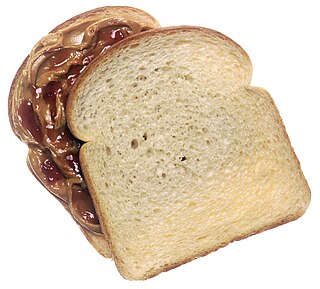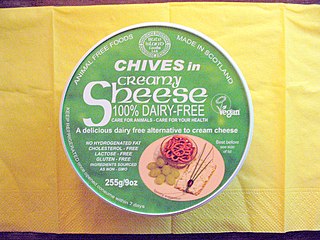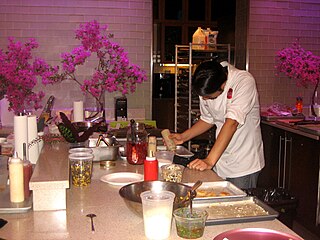 W
WThe food industry is a complex, global network of diverse businesses that supplies most of the food consumed by the world's population. The term food industries covers a series of industrial activities directed at the production, distribution, processing, conversion, preparation, preservation, transport, certification and packaging of foodstuffs. The food industry today has become highly diversified, with manufacturing ranging from small, traditional, family-run activities that are highly labor-intensive, to large, capital-intensive and highly mechanized industrial processes. Many food industries depend almost entirely on local agriculture, produce, or fishing.
 W
WAn adulterant is a substance found within other substances such as food, cosmetics, pharmaceuticals, fuel or other chemicals that compromises the safety or effectiveness of said substance.
 W
WAgricultural marketing covers the services involved in moving an agricultural product from the farm to the consumer. These services involve the planning, organizing, directing and handling of agricultural produce in such a way as to satisfy farmers, intermediaries and consumers. Numerous interconnected activities are involved in doing this, such as planning production, growing and harvesting, grading, packing and packaging, transport, storage, agro- and food processing, provision of market information, distribution, advertising and sale. Effectively, the term encompasses the entire range of supply chain operations for agricultural products, whether conducted through ad hoc sales or through a more integrated chain, such as one involving contract farming.
 W
WAgriculture is the science, art and practice of cultivating plants and livestock. Agriculture was the key development in the rise of sedentary human civilization, whereby farming of domesticated species created food surpluses that enabled people to live in cities. The history of agriculture began thousands of years ago. After gathering wild grains beginning at least 105,000 years ago, nascent farmers began to plant them around 11,500 years ago. Pigs, sheep, and cattle were domesticated over 10,000 years ago. Plants were independently cultivated in at least 11 regions of the world. Industrial agriculture based on large-scale monoculture in the twentieth century came to dominate agricultural output, though about 2 billion people still depended on subsistence agriculture.
 W
WAn automated tank cleaning machine is a machine used to clean cargo, process, underground storage tanks and similar equipment such as those found in tank trucks, railroad cars, barges, oil tankers, food and beverage manufacturing facilities, chemical processing plants, ethanol plants, and brewing facilities. Genericized trademarks such as Gamajet and Butterworth machine are often used to refer to automatic tank cleaning machines regardless of their manufacturer.
 W
WBaladna is a Qatari agricultural company that raises livestock and produces dairy products. It is Qatar's largest locally-owned food and dairy producer, supplying over 95% of the country's fresh dairy products.
 W
WBread crumbs or breadcrumbs consist of crumbled bread of various dryness, sometimes with seasonings added, used for breading or crumbing foods, topping casseroles, stuffing poultry, thickening stews, adding inexpensive bulk to soups, meatloaves and similar foods, and making a crisp and crunchy covering for fried foods, especially breaded cutlets like tonkatsu and schnitzel. The Japanese variety of bread crumbs is called panko.
 W
WDry ice blasting is a form of carbon dioxide cleaning, where dry ice, the solid form of carbon dioxide, is accelerated in a pressurized air stream and directed at a surface in order to clean it.
 W
WAn enrober is a machine used in the confectionery industry to coat a food item with a coating medium, typically chocolate. Foods that are coated by enrobers include nuts, ice cream, toffee, candy bars, biscuits and cookies. Enrobing with chocolate extends a confection's shelf life.
 W
WExtrusion is a process used to create objects of a fixed cross-sectional profile. A material is pushed through a die of the desired cross-section. The two main advantages of this process over other manufacturing processes are its ability to create very complex cross-sections, and to work materials that are brittle, because the material only encounters compressive and shear stresses. It also forms parts with an excellent surface finish and gives considerable freedom of form in the design process.
 W
WA Factory-kitchen or kitchen factory was a large mechanized enterprise of food service in the Soviet Union, originated in the 1920–1930s. Its main purpose was centralized preparation of food supplied for communal dining rooms or for personal purchase. Factory-kitchens were characteristic of their unique architecture. Sometimes the term is inadequately translated as communal kitchen, the latter being a kitchen in a Soviet communal apartment.
 W
WRetail food delivery is a courier service in which a restaurant, store, or independent food-delivery company delivers food to a customer. An order is typically made either through a restaurant or grocer's website or mobile app, or through a food ordering company. The delivered items can include entrees, sides, drinks, desserts, or grocery items and are typically delivered in boxes or bags. The delivery person will normally drive a car, but in bigger cities where homes and restaurants are closer together, they may use bikes or motorized scooters. Recently, we have also seen the use of autonomous vehicles by companies like Starship Technologies, currently available in the USA and the UK to complete deliveries.
 W
WFood distribution is a process in which a general population is supplied with food. The Food and Agriculture Organization (FAO) considers food distribution as a subset of the food system. The process and methodology behind food distribution varies by location. Food distribution has been a defining characteristic of human behavior in all societies, and recordings of food distribution date back for thousands of years. Most governments and societies are highly shaped by the systems created to support food distribution.
 W
WFood engineering is a scientific, academic, and professional field that interprets and applies principles of engineering, science, and mathematics to food manufacturing and operations, including the processing, production, handling, storage, conservation, control, packaging and distribution of food products. Given its reliance on food science and broader engineering disciplines such as electrical, mechanical, civil, chemical, industrial and agricultural engineering, food engineering is considered a multidisciplinary and narrow field. Due to the complex nature of food materials, food engineering also combines the study of more specific chemical and physical concepts such as biochemistry, microbiology, food chemistry, thermodynamics, transport phenomena, rheology, and heat transfer. Food engineers apply this knowledge to the cost-effective design, production, and commercialization of sustainable, safe, nutritious, healthy, appealing, affordable and high-quality ingredients and foods, as well as to the development of food systems, machinery, and instrumentation.
 W
WExtrusion is used in food processing, forcing soft mixed ingredients through an opening in a perforated plate or die designed to produce the required shape. The extruded food is then cut to a specific size by blades. The machine which forces the mix through the die is an extruder, and the mix is known as the extrudate. The extruder is typically a large, rotating screw tightly fitting within a stationary barrel, at the end of which is the die.
 W
WFood grading involves the inspection, assessment and sorting of various foods regarding quality, freshness, legal conformity and market value. Food grading often occurs by hand, in which foods are assessed and sorted. Machinery is also used to grade foods, and may involve sorting products by size, shape and quality. For example, machinery can be used to remove spoiled food from fresh product.
 W
WA food hub, as defined by the USDA, is “a centrally located facility with a business management structure facilitating the aggregation, storage, processing, distributions, and/or marketing of locally/regionally produced food products.” Food hubs are a part of the agricultural value chain model and often share common values relating to conservation, sustainability, healthy food access, and supporting local farmers. A defining characteristic of food hubs is source identification, a food safety and marketing benefit that allows consumers to trace the origin of products they buy. One of the primary goals of food hubs is to give small and medium-sized farmers access to larger or additional markets. Food hubs also fill gaps in food systems infrastructure, such as transportation, product storage, and product processing. Although companies and organizations that fit the USDA definition have been operating in the United States since at least the early 1970s, most food hubs, as well as the common use of the term, started in or after 2008.
 W
WFood miles is the distance food is transported from the time of its making until it reaches the consumer. Food miles are one factor used when testing the environmental impact of food, such as the carbon footprint of the food.
 W
WFood prices refer to the average price level for food across countries, regions and on a global scale. Food prices have an impact on producers and consumers of food.
 W
WFood processing is the transformation of agricultural products into food, or of one form of food into other forms. Food processing includes many forms of processing foods, from grinding grain to make raw flour to home cooking to complex industrial methods used to make convenience foods. Some food processing methods play important roles in reducing food waste and improving food preservation, thus reducing the total environmental impact of agriculture and improving food security.
 W
WFood rheology is the study of the rheological properties of food, that is, the consistency and flow of food under tightly specified conditions. The consistency, degree of fluidity, and other mechanical properties are important in understanding how long food can be stored, how stable it will remain, and in determining food texture. The acceptability of food products to the consumer is often determined by food texture, such as how spreadable and creamy a food product is. Food rheology is important in quality control during food manufacture and processing. Food rheology terms have been noted since ancient times. In ancient Egypt, bakers judged the consistency of dough by rolling it in their hands.
 W
WFutureFeed is a seaweed-based feed ingredient for livestock that is currently being developed by a dedicated team from Australia's Commonwealth Scientific and Industrial Research Organisation (CSIRO). The primary component of FutureFeed is dried Asparagopsis, a genus of red algae, which has been shown to reduce the methane (CH4) emissions of ruminant livestock by up to 99%. It is added to fodder at feedlots in dosages of 1-2% dietary intake to achieve this result. FutureFeed is currently being developed in collaboration with James Cook University (JCU) and Meat and Livestock Australia (MLA), with the primary goal of scaling for mainstream commercial use.
 W
WGenetically modified foods, also known as genetically engineered foods, or bioengineered foods are foods produced from organisms that have had changes introduced into their DNA using the methods of genetic engineering. Genetic engineering techniques allow for the introduction of new traits as well as greater control over traits when compared to previous methods, such as selective breeding and mutation breeding.
 W
WThe intensive agriculture of the province of Almeria, Spain, is a model of agricultural exploitation of high technical and economic yield based on the rational use of water, sanding, use of plastic greenhouses, high technical training and high level of employment of Inputs, on the peculiar characteristics of the environment. The greenhouses (invernaderos) are located between Motril and Almeria. Especially the area of El Ejido is well known to be an agricultural hotspot.
 W
WOlive oil extraction is the process of extracting the oil present in olive drupes, known as olive oil. Olive oil is produced in the mesocarp cells, and stored in a particular type of vacuole called a lipo vacuole, i.e., every cell contains a tiny olive oil droplet. Olive oil extraction is the process of separating the oil from the other fruit contents. It is possible to attain this separation by physical means alone, i.e., oil and water do not mix, so they are relatively easy to separate. This contrasts with other oils that are extracted with chemical solvents, generally hexane. The first operation when extracting olive oil is washing the olives, to reduce the presence of contaminants, especially soil which can create a particular flavor effect called "soil taste".
 W
WOpen Food Facts is a free, online and crowdsourced database of food products from around the world licensed under the Open Database License (ODBL) while its artwork—uploaded by contributors—is distributed under a Creative Commons Attribution–Share Alike license.
 W
WServing suggestion is a disclaimer used on food packaging. The phrase is used as legal fine print with a picture of the product. The picture attempts to portray the manufacturer's food in the most favorable or appetizing way possible, sometimes including other foods that the package does not contain. For example, the labeling on a box of cereal may feature a picture of a cereal bowl filled with that cereal, milk and a fruit garnish, a cream cheese pack may feature a bagel with that cream cheese on it, or a jar of mustard may picture a hot dog in a bun with mustard on it. The serving suggestion may portray the serving size of the food used, but just as often a much larger serving is shown as part of the marketing of the item. As a disclaimer a serving suggestion also serves to remove any legal obligation on the part of the manufacturer to provide the other items pictured with their product.
 W
WSpray drying is a method of producing a dry powder from a liquid or slurry by rapidly drying with a hot gas. This is the preferred method of drying of many thermally-sensitive materials such as foods and pharmaceuticals. A consistent particle size distribution is a reason for spray drying some industrial products such as catalysts. Air is the heated drying medium; however, if the liquid is a flammable solvent such as ethanol or the product is oxygen-sensitive then nitrogen is used.
 W
WThe sugar industry subsumes the production, processing and marketing of sugars. Globally, most sugar is extracted from sugar cane and sugar beet.
 W
WA test kitchen is a kitchen used for the process of developing new kinds of food. On the largest scale, they are run by the research and development departments of large companies in the food industry. Other test kitchens are owned by individuals who enjoy the craft of developing new recipes.